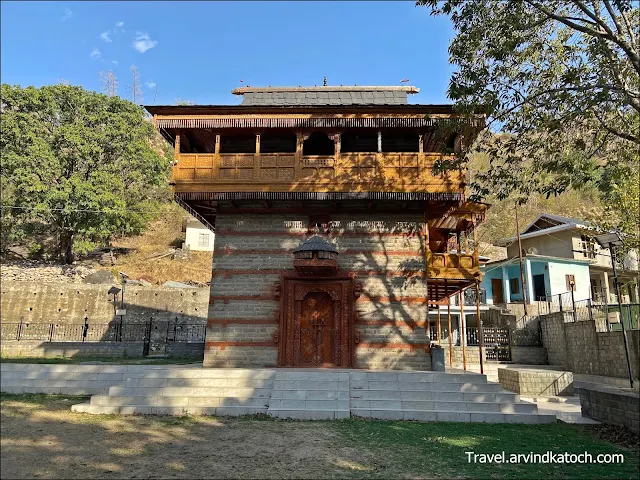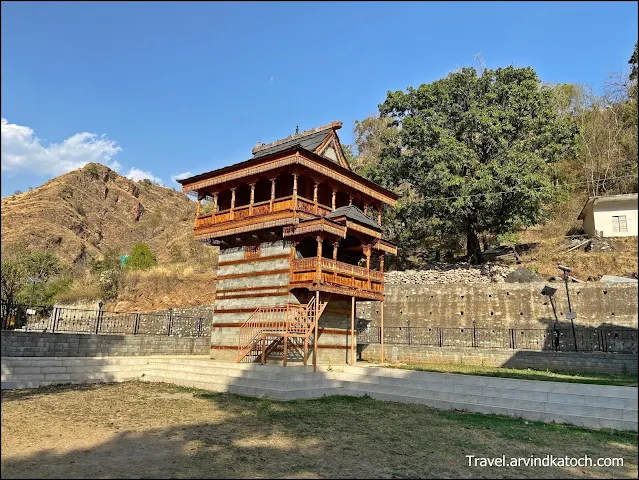Discovering the Hidden Gem: Pandoi Devta Temple near Luhri
As you know, I recently embarked on a memorable road trip covering the Nalagarh–Ramshehr–Arki–Basantpur–Luhri–Anni stretch. While traveling from Basantpur toward Tatapani, we took a right turn onto MDR 22 towards Luhri and Rampur. From that point onward, the journey beautifully traced the course of the Satluj River, offering constant views of riverbank communities and a fascinating glimpse into their rich cultures and traditions.
Today, I want to share a hidden treasure we discovered along the way: the Pandoi Devta Temple, located just a few meters off the main road at Pandoa village.
Pandoi Devta Temple: A Glimpse into History and Faith
Himachal Pradesh is often called the land of gods, home to thousands of deities revered by local communities. True to this spirit, the Pandoi Devta Temple stands quietly tucked away, hidden from the main road. To reach it, one must take a narrow, unpaved track about 300 meters long, leading into a serene landscape.
The temple complex consists of one main temple and two Kothis (smaller shrines or auxiliary structures).
At this sacred site, we find a Shivlinga that closely resembles the famous one in Ujjain’s Mahakaleshwar Temple. Because of this striking similarity, the temple is also known as Mahakaleshwar Pandoi Devta Ji Sahib. It is believed that this Shivlinga was established by the Pandavas during their period of exile. In fact, the name "Pandoa" is said to have evolved from "Pandowas," linking the village directly to these ancient legends.
Architecture: A Unique Blend of Stone, Wood, and Craftsmanship
One of the most striking features of the Pandoi Devta Temple is its construction. The lower portion of the temple walls is crafted using alternating layers of **stone and wood**, interwoven skillfully to form a strong and earthquake-resistant structure. This traditional technique is unique to the hilly regions of Himachal, particularly seen in older structures across the Kullu and Shimla districts.
The temple also showcases intricate hand-carved wooden artwork, a fine display of craftsmanship rarely seen elsewhere in India today. The delicate carvings on the wood are mesmerising at first glance, reflecting the deep artistic heritage of the region. If you’ve seen the Hatu Mata Temple near Narkanda, you will recognize a similar architectural style.
The Spiritual and Cultural Significance
Although the temple we visited is newly constructed, an older, original temple still exists atop the nearby Kotighat hill. This ancient site remains relatively inaccessible due to the lack of direct road connectivity. The idol of the main deity, Pandoi Devta, is occasionally moved between the new and old temples for traditional rituals.
In this part of Himachal, hill areas are divided among local deities, each overseeing their respective regions. The surroundings of both the upper and lower temples fall under the jurisdiction of the Pandoi Devta. People from the surrounding villages hold immense faith in him, often visiting the temple to seek blessings for protection, prosperity, and wellbeing.
A Hidden Gem Worth Visiting
Visiting the Pandoi Devta Temple was truly a serendipitous experience. Thanks to the guidance of a helpful local, we stumbled upon this hidden gem near MDR 22. The peaceful environment, fascinating architecture, and strong spiritual aura made it a deeply memorable stop on our journey.
For travelers who seek to go beyond the typical tourist routes, discovering places like the Pandoi Devta Temple offers a genuine connection with the timeless culture and spirituality of Himachal Pradesh. It’s a reminder that sometimes, the most beautiful experiences lie just a short, unmarked path away.
Watch the Video of Lower Pandoi Devta Temple-




